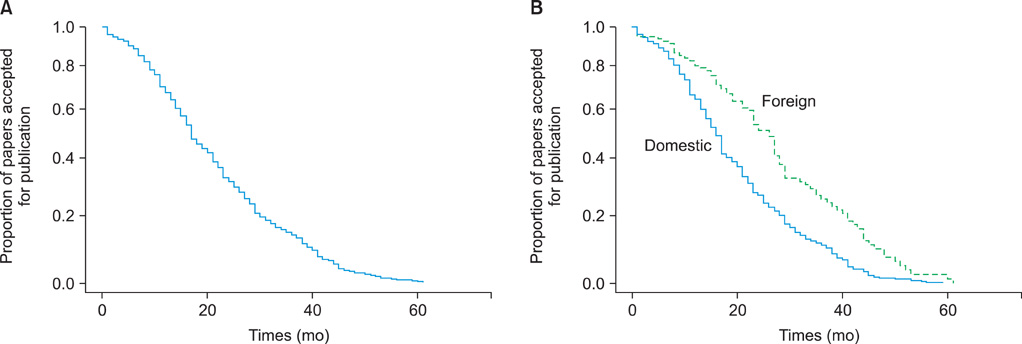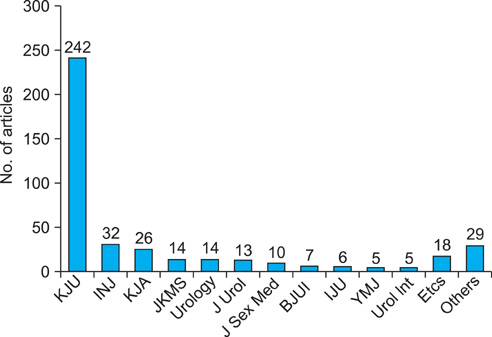Korean J Urol.
2012 Apr;53(4):280-284.
Fate of Abstracts Presented at the Annual Meeting of the Korean Urological Association
- Affiliations
-
- 1Department of Urology, Hanyang University College of Medicine, Seoul, Korea. swleepark@hanyang.ac.kr
- 2Section of Advanced Laparoscopy and Robotics, Glickman Urological and Kidney Institute, Cleveland Clinic, Cleveland, OH, USA.
- 3Department of Urology, Urological Science Institute, Yonsei University Health System, Seoul, Korea.
Abstract
- PURPOSE
The acceptance rate for journal publication of the abstracts presented at the annual Korean Urological Association (KUA) meeting, the time to publication, and the effect of abstract characteristics on the publication pattern were analyzed and compared with data for abstracts from other major urological meetings.
MATERIALS AND METHODS
A total of 1,005 abstracts listed in the abstract books of the 2006 (58th) and 2007 (59th) annual KUA meetings were analyzed, and their subsequent publication as listed in PubMed or KoreaMed between August 2006 and August 2011 was evaluated.
RESULTS
A total of 41.59% of abstracts were published as full-length reports. Abstracts on sexual dysfunction, neurourology, prostate cancer, basic research, and benign prostatic hyperplasia showed the highest publication rates (54%, 52.27%, 48%, 47.56%, and 45%, respectively). It took 19.01+/-12.83 months on average for abstracts to be published in a journal, whereas it took 25.24+/-14.64 months and 17.51+/-11.89 months for publication in foreign and Korean journals, respectively (p<0.001).
CONCLUSIONS
Approximately 40% of studies presented as abstracts at the KUA meeting are subsequently published as full-length articles. The KJU is the most targeted journal. The mean time to publication is 1.5 years, and publication seems to be influenced by the study subject.
Keyword
Figure
Reference
-
1. Stolk P, Egberts AC, Leufkens HG. Fate of abstracts presented at five International Conferences on Pharmacoepidemiology (ICPE): 1995-1999. Pharmacoepidemiol Drug Saf. 2002. 11:105–111.2. Scherer RW, Langenberg P, von Elm E. Full publication of results initially presented in abstracts. Cochrane Database Syst Rev. 2007. (2):MR000005.3. Ng L, Hersey K, Fleshner N. Publication rate of abstracts presented at the annual meeting of the American Urological Association. BJU Int. 2004. 94:79–81.4. Autorino R, Quarto G, Di Lorenzo G, De Sio M, Damiano R. Are abstracts presented at the EAU meeting followed by publication in peer-reviewed journals? A critical analysis. Eur Urol. 2007. 51:833–840.5. Autorino R, Quarto G, Di Lorenzo G, Giugliano F, Quattrone C, Neri F, et al. What happens to the abstracts presented at the Societè Internationale d'Urologie meeting? Urology. 2008. 71:367–371.6. Autorino R, Quarto G, Sio MD, Lima E, Quarto E, Damiano R, et al. Fate of abstracts presented at the World Congress of Endourology: are they followed by publication in peer-reviewed journals? J Endourol. 2006. 20:996–1001.7. Rao AR, Beatty JD, Laniado M, Motiwala HG, Karim OM. Publication rate of abstracts presented at the British Association of Urological Surgeons Annual Meeting. BJU Int. 2006. 97:306–309.8. Hoag CC, Elterman DS, Macneily AE. Abstracts presented at the American Urological Association Annual Meeting: determinants of subsequent peer reviewed publication. J Urol. 2006. 176(6 Pt 1):2624–2629.9. Smith WA, Cancel QV, Tseng TY, Sultan S, Vieweg J, Dahm P. Factors associated with the full publication of studies presented in abstract form at the annual meeting of the American Urological Association. J Urol. 2007. 177:1084–1088.10. Cartwright R, Khoo AK, Cardozo L. Publish or be damned? The fate of abstracts presented at the International Continence Society Meeting 2003. Neurourol Urodyn. 2007. 26:154–157.11. Gourtaud G, Bruyère F. What is the publication rate of papers presented at the French Association of Urology annual conferences? Prog Urol. 2009. 19:60–64.12. Weber EJ, Callaham ML, Wears RL, Barton C, Young G. Unpublished research from a medical specialty meeting: why investigators fail to publish. JAMA. 1998. 280:257–259.13. Dickersin K, Min YI, Meinert CL. Factors influencing publication of research results. Follow-up of applications submitted to two institutional review boards. JAMA. 1992. 267:374–378.14. Arrivé L, Boelle PY, Dono P, Lewin M, Monnier-Cholley L, Tubiana JM. Subsequent publication of orally presented original studies within 5 years after 1995 RSNA Scientific Assembly. Radiology. 2004. 232:101–106.15. Saha S, Saint S, Christakis DA. Impact factor: a valid measure of journal quality? J Med Libr Assoc. 2003. 91:42–46.16. Callaham ML, Wears RL, Weber EJ, Barton C, Young G. Positive-outcome bias and other limitations in the outcome of research abstracts submitted to a scientific meeting. JAMA. 1998. 280:254–257.17. Berry E, Kelly S, Hutton J, Harris KM, Smith MA. Identifying studies for systematic reviews. An example from medical imaging. Int J Technol Assess Health Care. 2000. 16:668–672.
- Full Text Links
- Actions
-
Cited
- CITED
-
- Close
- Share
- Similar articles
-
- Fate of abstracts presented at the Turkish Association of Oral and Maxillofacial Surgeons (TAOMS) meetings between 2007 and 2009
- Highlights for the 2019 American Society of Clinical Oncology (ASCO) Annual Meeting
- Past, Present, and Future of Academic Conference in Korean Neuropsychiatric Association
- Analysis of Publication Status of Abstracts Presented at the Annual Meeting of the Korean Academy of Rehabilitation Medicine
- Publication rate of presentations at Korean plastic surgery meetings: The R&R Forum, KSAPS, and KSPRS (2011–2015)



